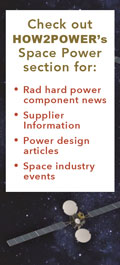
 |
 |

|
HOW2POWER EXCLUSIVE DESIGN ARTICLES 
|
Injecting Noise In Power Supplies Improves Security For Communications Devices
by Gregory Mirsky, Vitesco Technologies, A Spinoff Of Continental Automotive Systems, Deer Park, Ill.
In communication devices such as cell phones, voice-generated audio signals that pass through audio amplifiers modulate the dc supply voltage and thus they also modulate the switching waveforms that control and regulate switching power supplies. As any switching power supply has some electromagnetic emission at the switching frequency and its harmonics or unwanted derivatives (ringing), the modulating voice-generated information is emitted as well. There is a very simple way of safeguarding this audio information. This method hampers eavesdropping of any emitted signal, can be used with practically any existing switching power supply and is applicable to any device processing information, both digital and analog. The proposed method uses noise to modulate the power supply switching signal.
Read the article…
|

A simple circuit for injecting noise
current into a power supply’s feedback
circuit, modulates the power supply’s
switching signal, masking any audio
modulation it may contain. |

|

This two-port model is used to
analyze dc-dc converter dynamics
and derive equations that express
the system sensitivities to source-side
and load-side interactions. |
The Engineer’s Guide To EMI In DC-DC Converters (Part 11): Input Filter Impact On Dynamic Performance
by Timothy Hegarty, Texas Instruments, Phoenix, Ariz.
Meeting electromagnetic interference (EMI) standards requires the insertion of an EMI filter between a switching-mode power converter and its source. As described in part 10 of this series, a dynamic coupling between a converter and its EMI filter effectively creates a feedback loop, where the source-side “minor-loop” gain is the ratio of the filter’s output impedance to the converter’s closed-loop input impedance. Given the negative input impedance behavior of a regulated, high-loop-gain dc-dc converter, part 10 showed that impedance shaping (via passive damping of the input filter to reduce its output impedance peaking) is normally required to ensure robust stability. However, there’s another concern as input-filter interactions may severely affect the transfer functions related to dynamic performance of the converter, particularly the loop gain and output impedance characteristics. The impact of those input-filter interactions on the converter’s dynamic performance are considered here.
Read the article…
|

A Guide To Second Sourcing Rectifiers
by Jos van Loo, Taiwan Semiconductor Europe, Zorneding, Germany and Kevin Parmenter, Taiwan Semiconductor America, Chandler, Ariz.
Rectifiers are usually not very high on the priority list of most designers. Once designed-in on a PCB and qualified, the sources of these components are rarely changed to other suppliers. However, if problems happen in the supply chain or a supplier end of lifes parts, then attempts will be made to second source them. This article describes some of the problems that can occur when you second source rectifiers. Although testing is necessary in many cases, by better understanding the manufacturing processes, datasheets and technology, the testing can be more focused and failures in mass production can be avoided. Test programs and statistics provided by the manufacturer should also be considered. We will start by discussing some general issues that arise when cross referencing standard rectifiers. Afterwards we will go into the details that apply when looking specifically at bridge rectifiers, fast recovery and fast efficient rectifiers, Schottky diodes, TVS diodes, small-signal products and zeners.
Read the article…
|

Unlike derating curves, the typical Vf
curve cannot be manipulated by a
vendor and allows you to indirectly
determine die size. |

FOCUS ON MAGNETICS 
Sponsored by Payton Planar Magnetics
A monthly column presenting information on power magnetics design, products, or related technology |

Deflux Windings Benefit Forward Converters But Not Flybacks
by Dennis Feucht, Innovatia Laboratories, Cayo, Belize
A circuit technique that increases the efficiency of low to medium-power (<1 kW) converters with transductors (multiple-winding magnetic components) is to add a winding that conducts current during the on-time to off-time transition, returning the leakage-inductance energy to either input or output port. This article demonstrates how this technique for defluxing the primary winding works in the forward converter and also, why it is not feasible for flyback converters. This discussion thereby demonstrates the more detailed magnetics behavior of deflux circuits. For those familiar with active-clamp “reset” techniques, the method described here for recovering the transformer’s leakage energy is similar in function, but simpler in that it only requires the addition of a small winding and a diode.
Read the full article…
|

 |
 |

SPOTLIGHT ON SAFETY & COMPLIANCE 
Sponsored by Power Integrations
A monthly column discussing standards and regulatory requirements affecting power electronics |

APEC 2020 Resources Help Engineers Address Power Supply Safety and Compliance Needs
by Kevin Parmenter, Chair, and James Spangler, Co-chair, PSMA Safety and Compliance Committee
APEC season is coming up soon and this means the brightest minds and top suppliers in the power electronics industry will be gathered in one place. This year the IEEE Applied Power Electronics Conference (APEC 2020) will be in New Orleans, March 15-19 and as always, we will be there to participate. Over 300 exhibitors will be there this year showcasing their latest technologies and practical solutions to proximate problems in our industry. From a safety and compliance standpoint, this unique collection of suppliers and service providers presents a special opportunity to obtain the components, tools and advice we need as engineers to meet our regulatory requirements.
Read the full article…
|

 |
 |

 — POWER PRODUCTS IN 3 IMAGES OR LESS — POWER PRODUCTS IN 3 IMAGES OR LESS 
|

|

Infineon Technologies’ FF900R12ME7_B11
and FF900R12ME7P_B11
IGBT modules. |
IGBT Modules Offer 1200-V, 900-A Ratings For Medium Power Drives
 Photo: By implementing the TRENCHSTOP IGBT7 chip in the industry-standard EconoDUAL 3 package, these IGBT modules provide a nominal current of 900 A. This enables a 30% higher inverter output current for the same frame size compared with the company’s previous technology, IGBT4. Photo: By implementing the TRENCHSTOP IGBT7 chip in the industry-standard EconoDUAL 3 package, these IGBT modules provide a nominal current of 900 A. This enables a 30% higher inverter output current for the same frame size compared with the company’s previous technology, IGBT4.
See the full story… |




Renesas’ RV1S92xxA and
RV1S22xxA photocouplers. |
Photocouplers Shrink Designs For Industrial Automation And Solar Inverters
 Photo: The five 8.2-mm creepage photocouplers help designers shrink equipment size, increase robot axes and improve factory floor productivity. They feature a 2.5-mm package width, which is said to reduce PCB mounting area by 35% compared to competing couplers. They also have a 2.1-mm package height, allowing them to be mounted on the backside of a PCB. Photo: The five 8.2-mm creepage photocouplers help designers shrink equipment size, increase robot axes and improve factory floor productivity. They feature a 2.5-mm package width, which is said to reduce PCB mounting area by 35% compared to competing couplers. They also have a 2.1-mm package height, allowing them to be mounted on the backside of a PCB.
See the full story…
|

ABSOPULSE Electronics’ HTH
1K-F6W ac-dc power supply.
|
1-kW, 400-V Power Supply Suits Industrial Applications
 Photo: Designed for heavy-duty industrial applications such as such as dc motor control, battery charging, dc bus voltage for distributed systems and power servos, this ac-dc power supply delivers 1 kW at 200 V while operating from a 340- to 446-Vac three-phase input. Photo: Designed for heavy-duty industrial applications such as such as dc motor control, battery charging, dc bus voltage for distributed systems and power servos, this ac-dc power supply delivers 1 kW at 200 V while operating from a 340- to 446-Vac three-phase input.
See the full story…
|



STMicroelectronics’ STPMIC1
power-management IC.
|
PMIC Powers Application-Processor-Based Systems
 Diagram: The fully integrated power management IC is designed for products based on highly integrated application processor designs requiring low power and high efficiency. The PMIC’s regulators are designed to supply power to the application processor as well as to external system peripherals such as DDR, Flash memories and other system devices. The device also integrates advanced low-power features controlled by a host processor via I2C and IO interface. Diagram: The fully integrated power management IC is designed for products based on highly integrated application processor designs requiring low power and high efficiency. The PMIC’s regulators are designed to supply power to the application processor as well as to external system peripherals such as DDR, Flash memories and other system devices. The device also integrates advanced low-power features controlled by a host processor via I2C and IO interface.
See the full story…
|

|










|
INDUSTRY EVENTS  |
|
CES 2020: Automotive And Health Fields Drive Much Tech Development
by David G. Morrison, Editor, How2Power.com
With more than 4000 companies exhibiting and over 170,000 attendees participating in the recently held CES 2020, the world’s largest technology show can be difficult to describe. Hosted by the Consumer Technology Association, and once referred to as the Consumer Electronics Show, this is a tech show that showcases all tech products for humans. With the word consumer attached to the show, we might think these products are just for personal use, at home or in our daily travels. But there are products at CES relating to nearly all imaginable aspects of daily life including products for the office, factory or other work settings. From a power electronics perspective, CES is a bellwether of the applications that will influence power semiconductor and power supply development now and in the future. As I toured the exhibit halls in the Tech West and Tech East venues at CES 2020 last week, I observed some of the dominant themes, technologies and power-related trends.
Read the full story… |
|
3D-PEIM Issues Call For Papers
The Third International Symposium on 3D Power Electronics Integration and Manufacturing (3D-PEIM), which will be held June 22-24, 2020 in Osaka, Japan, has issued its call for papers. This symposium will bring together practitioners and researchers to share, discuss and roadmap the latest developments in circuits and systems enabled through advancements in 3D packaging, integration and manufacturing technologies.
See the call for papers… |

|


 |
|  |

 |
|  |
ABOUT THIS NEWSLETTER: Thank you for reading HOW2POWER TODAY.
How2Power sends no more than one e-mail per month to registered users. Continuing your subscription ensures you'll receive future newsletters. Manage Your Subscription
©2020 All rights reserved. www.how2power.com
|
|